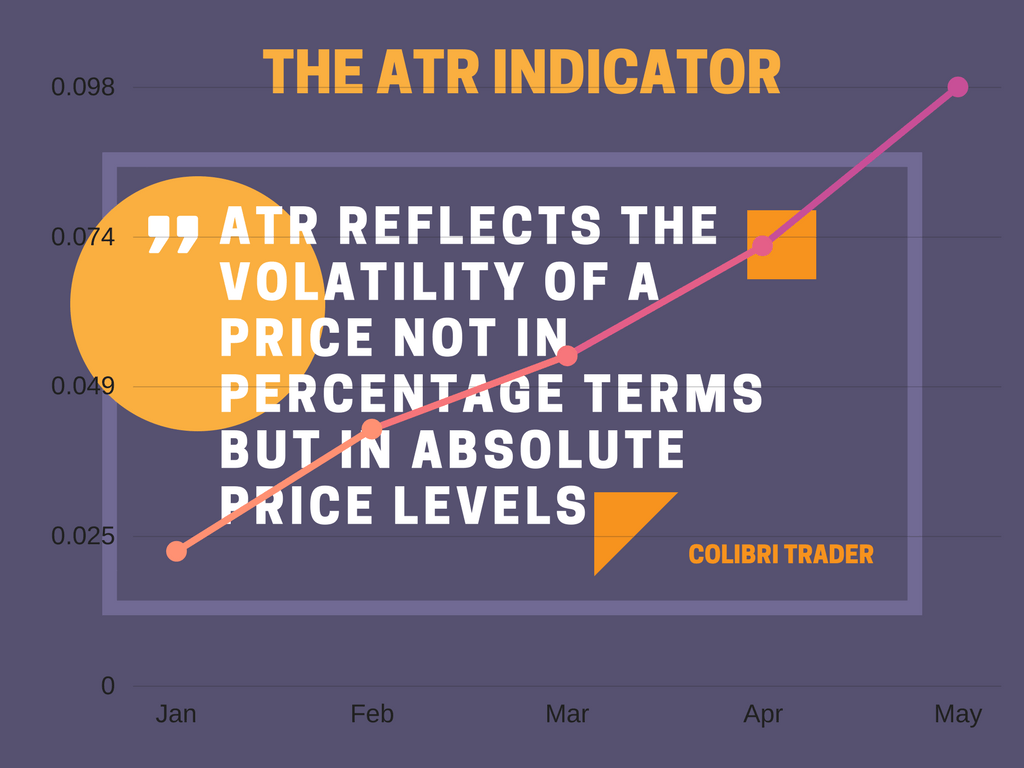
After reading this article on the ATR indicator, a trader will find out that:
- Originally developed by J. Welles Wilder, American mechanical engineer, in his book „New Concepts in Technical Trading Systems“
- Potential of confirming reversals
- Calculation of ATR Indicator
- Using for risk calcuation and position sizing

The Average True Range (ATR) is a simple yet very effective technical indicator, developed by the American mechanical engineer J.Welles Wilder. In his 1974 book „New Concepts in Technical Trading Systems“, Wilder featured the Average True Range indicator. He also developled other extremely popular technical indicators, like the RSI, Parabolic SAR and the ADX (Directional Movement Concept).
Originally developed for stocks and commodities, this indicator can also easily be adapted to Forex. The ATR indicator provides an indication of price volatility in absolute terms, as Wilders was not interested in price direction for this indicator. Wilders recommends using a 14-period ATR on a daily time-frame. Simply put, a currency pair which has larger movements and higher volatility, will also have a higher value for its ATR reading. On the other hand, a currency pair which is trading sideways will have a lower ATR reading. These values are of big interest to traders, as they can easily gauge the price volatility and make better decisions about position sizing, and the size of stop loss and limit orders. In some cases, the ATR can be used as a confirmation for bullish or bearish reversals. A growing ATR value in the beginning of a possible reversal might be used as a confirmation signal, as it shows rising momentum of long or short positions.
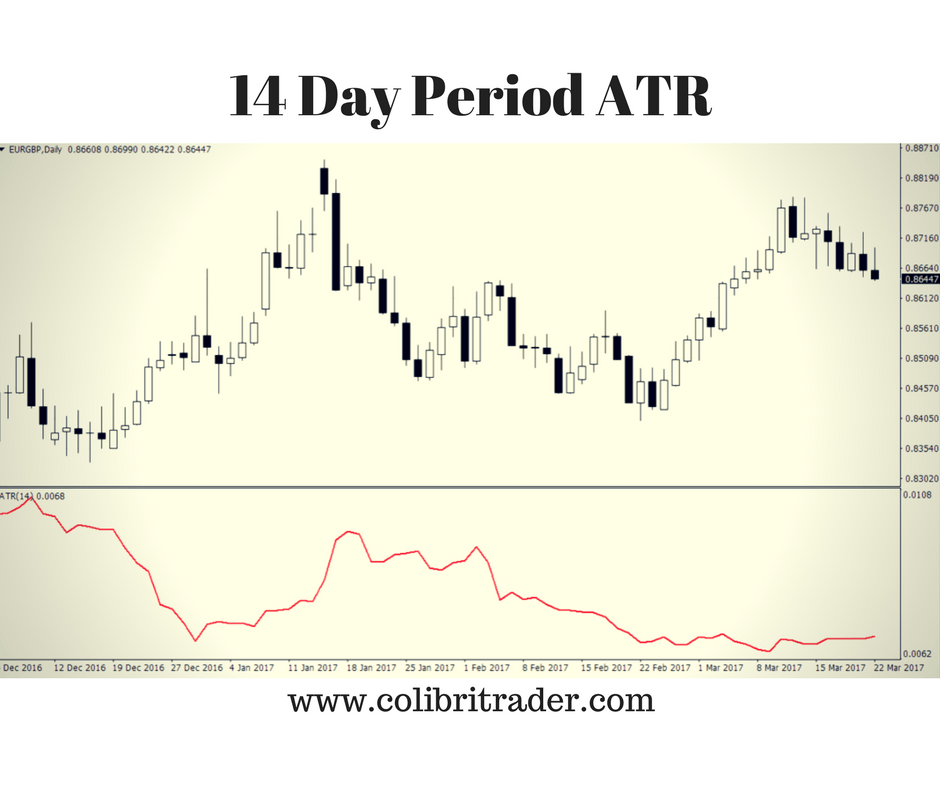
The Average True Range calculation is based on the N-day moving average of the true range values for a given currency pair (or other financial instrument).
The True Range is a concept Wilders described as the highest value of the following:
The current High minus the current Low
The absolute value of the current High minus the previous Close
The absoulute value of the current Low minus the previous Close
This concept is introduced because Wilders was interested in the price volatility of commodities during the development of the ATR indicator. As the trading volume on commodities is usually very low and thus price gaps often occur, simple volatility calculations based on the current Highs and Lows did not give adequate results. Instead, using True Ranges for volatility calculations, which take into account gaps from previous sessions, give much better results.
For example, if the current High is above the previous Close, and the current Low is equal or below the previous Close, then the current High minus Low will be used as the True Range value, that is method (a). On the other hand, if the current session opened with a gap or the current session is an inside bar, then methods (b) or (c) will be used, whichever is larger.
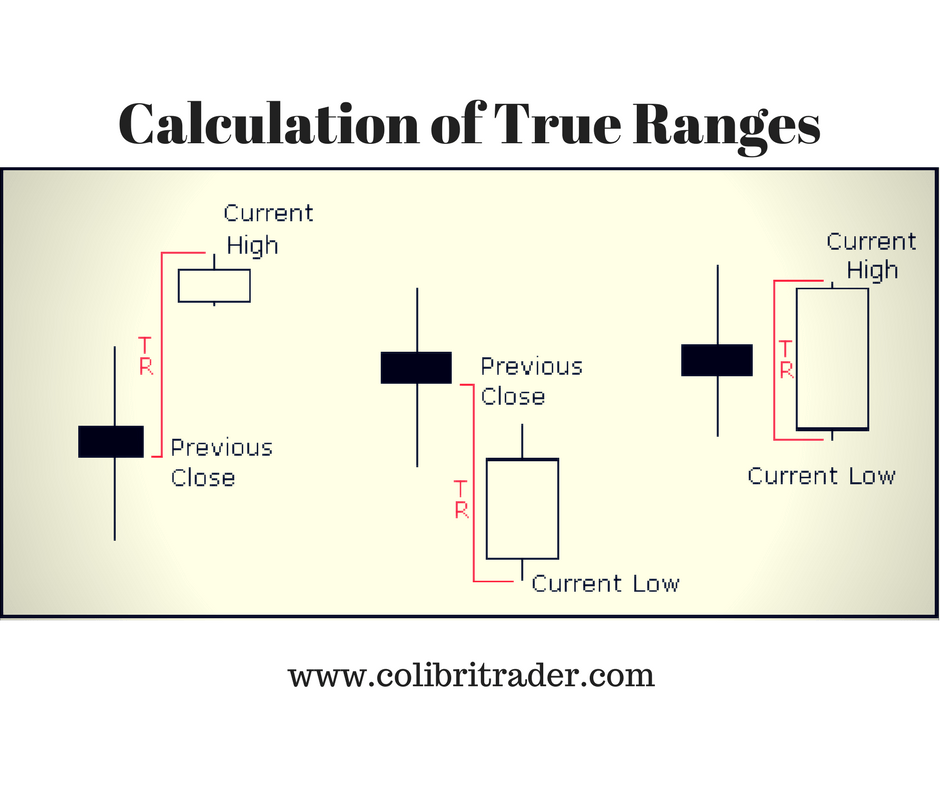
In the graphic above, the first price pattern shows a gap from the previous Close, and method (b) will be used for the True Range calculation. The second price pattern shows a gap to the downside, and therefore method (c) will be used. The third price patter shows an engulfing candlestick, with highs and lows outside the previous bar. Method (a) calculates the True Range in this case.
As said before, the recommended period for the ATR indicator is 14 days. This means, the value of the ATR will simply be the moving average of the 14 previous days.
Based on this statement, the acutal ATR is calculated using the following formula:

The current ATR value is equal to the previous ATR value multiplied with period-1, and added to the current True Range value. The result is then divided by the current period.
As we need a beginning value for the ATR, the ATR for the first 14 periods (assuming our ATR period is 14 days), is simply the average of the sums of True Ranges for the first 14 periods. The actual ATR formula shown above is used on the beginning of period 15.
Let’s take an example of the EUR/GBP currency pair:
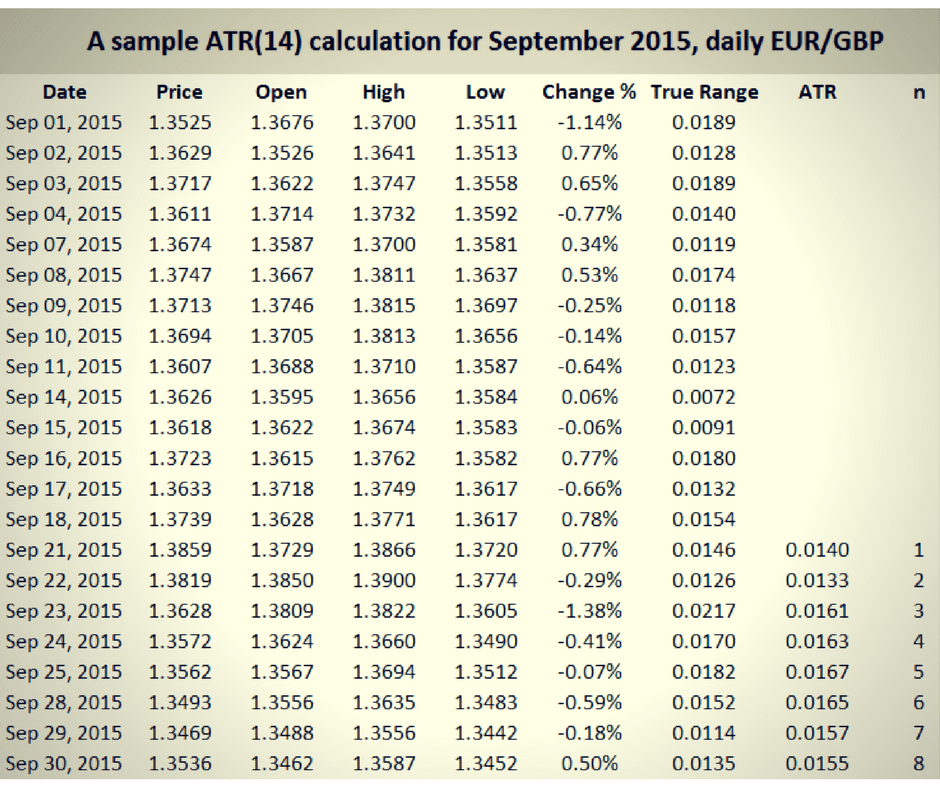
As can be seen on the above graphic, the True Ranges for the first 14 periods is calculated using one of the three mentioned methods above (a, b or c), and the actual ATR formula is used beginning of the 15th period. Although this is a relatively small sample, the purpose is purely to demonstrate the calculation of the ATR.
ATR is widely used for position-sizing. A currency pair (or other financial instrument) with a higher volatility and higher ATR, will require a larger stop-loss level than a currency pair with a lower ATR. The usual stop-loss level determined by this strategy is the current ATR level. Putting a stop-loss which is too large on a currency pair which has a low ATR, would create unnecessary risk for the trader. The opposite applies to currency pairs with high ATR readings. In this case the used stop-loss and take-profit levels should also be wider, as the position is on risk to be closed too early due to price volatility.
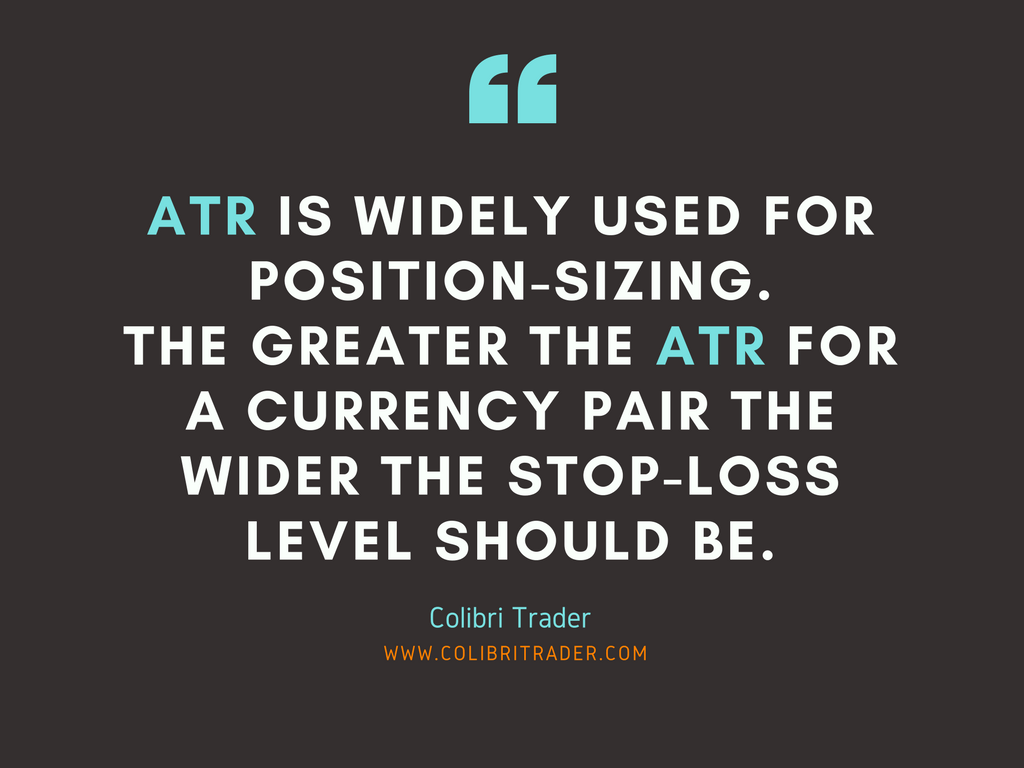
In general, the greater the ATR for a currency pair the wider the stop-loss level should be.
As ATR uses True Ranges for its calculation, which are in turn based on absolute price changes, ATR reflects the volatility of a price not in percentage terms but in absolute price levels. This means, a currency pair which usually has a high exchange rate (like GBP/JPY for example), will also have a higher ATR than a currency pair which trades on a lower exchange rate. These makes ATR comparisons between different currency pairs nearly impossible.
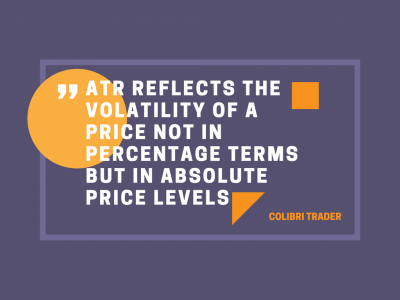
EXAMPLES:
#1 DAX Example
Let’s say you are going to execute a long trade at a certain point. You use the ATR indicator when determining where to place a stop-loss. Depending on which currency pair (or other instruement) you are trading, your stop-loss is a miltiple of the ATR. Let’s have a look at a specific example. This example is taken from a long entry on DAX. Let’s say that you enter in al ong trade at the circled area. Where would you place your stop-loss? Different traders use different settings, but a common approach is to take 1.5Xmultiple of the current ATR indicator reading. In the example below, the current ATR reading is 240. A trader using a 1.5X multiple willplace a stop-loss at 1.5x 240= 360 pips.
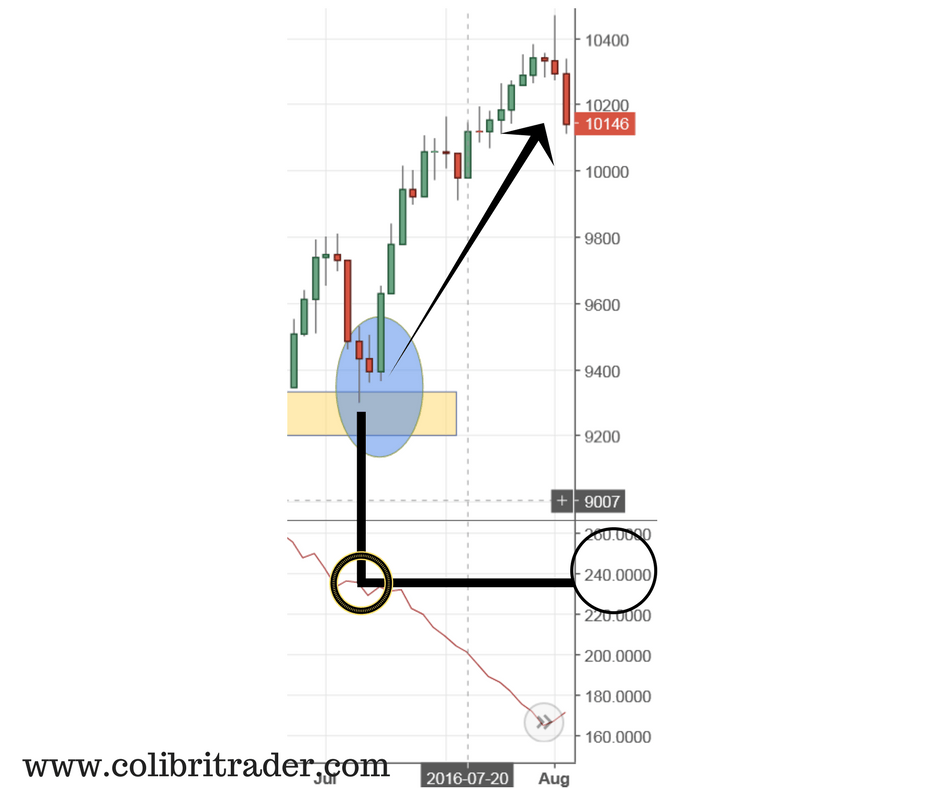
#2 EURUSD Example
In the second example, there is the EURUSD daily chart. Let’s say that in the beginning of march, we took this trade that is encircled. At the time of the trade, the ATR value was about 0.0080, which is the equivalent of 80 pips. Let’s say that you wanted to place a stop-loss- how much would have been that if you were using 1.5x multiplier? Yes, that would be exactly 120 pips. You need to experiement and see which vlaues work best for the instruments that you are trading.
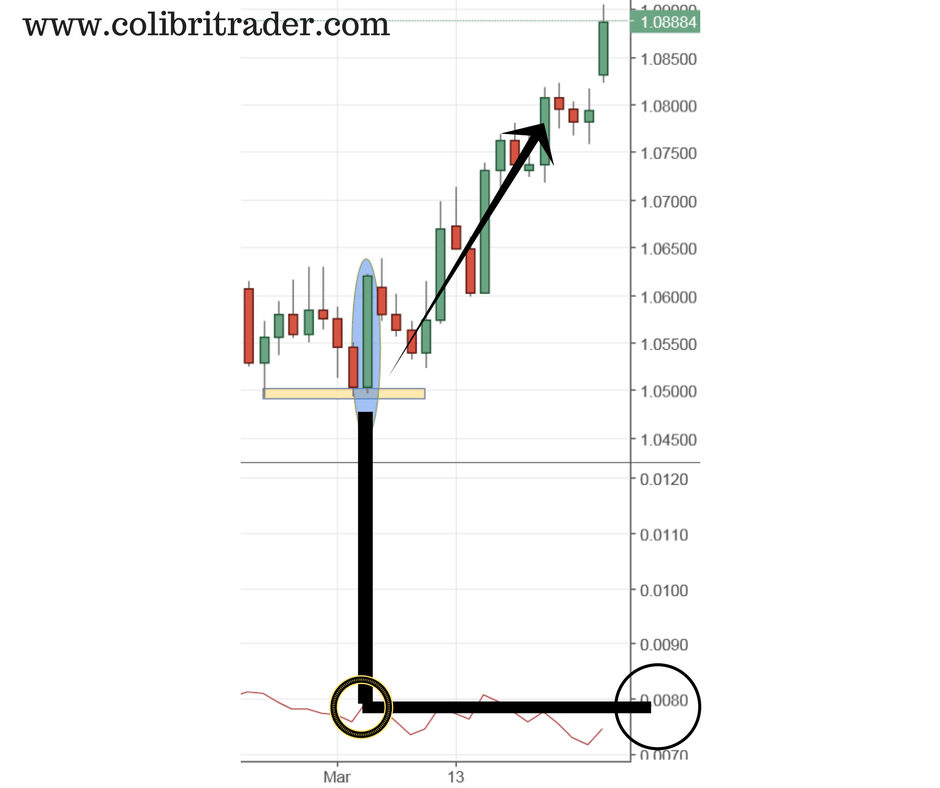
#3 AUDUSD Example
In the last example, I am showing a short trade on the AUDUSD. The ATR Indicator is showing a reading of 110 pips. You can see that the encircled area is between 0.0100 and 0.0120. This means that if a trader is about to take a short trade (and consider the 1.5X multiplier), the stop-loss should be placed 1.5x110pips= 165 pips away. In order to find a right combination, a trader must backtest and see what works best for a particular instrument. Therefore, it is essential that a lot of experimentation is performed before successful implementation.
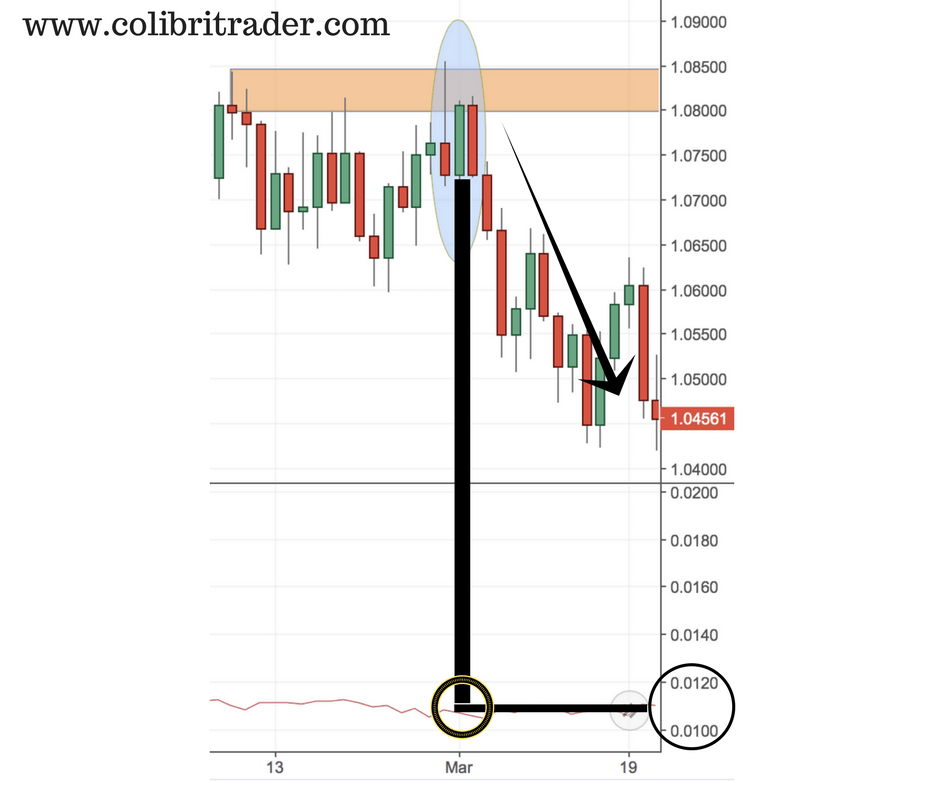
Conclusion
The Average True Range is a highly popular technical indicator which measures price volatility. ATR does not take into account the price direction, but can be useful in case of major bullish or bearish reversals. A growing ATR value just after the start of a potential reversal might be used as a confirmation signal. ATR indicator is widely used for risk calcualtions and position sizing. A currency pair with higher ATR readings require wider stops to be used, as price volatility can easily close an initially profitable position.
This material is written for educational purposes only. By no means do any of its contents recommend, advocate or urge the buying, selling or holding of any financial instrument whatsoever. Trading and Investing involves high levels of risk. The author expresses personal opinions and will not assume any responsibility whatsoever for the actions of the reader. The author may or may not have positions in Financial Instruments discussed in this newsletter. Future results can be dramatically different from the opinions expressed herein. Past performance does not guarantee future results.
Editors’ Picks

EUR/USD clings to small gains near 1.1750
Following a short-lasting correction in the early European session, EUR/USD regains its traction and clings to moderate gains at around 1.1750 on Monday. Nevertheless, the pair's volatility remains low, with investors awaiting this weeks key data releases from the US and the ECB policy announcements.

GBP/USD edges higher toward 1.3400 ahead of US data and BoE
GBP/USD reverses its direction and advances toward 1.3400 following a drop to the 1.3350 area earlier in the day. The US Dollar struggles to gather recovery momentum as markets await Tuesday's Nonfarm Payrolls data, while the Pound Sterling holds steady ahead of the BoE policy announcements later in the week.

Gold pulls away from session high, holds above $4,300
Gold loses its bullish momentum and retreats below $4,350 after testing this level earlier on Monday. XAU/USD, however, stays in positive territory as the US Dollar remains on the back foot on growing expectations for a dovish Fed policy outlook next year.

Solana consolidates as spot ETF inflows near $1 billion signal institutional dip-buying
Solana price hovers above $131 at the time of writing on Monday, nearing the upper boundary of a falling wedge pattern, awaiting a decisive breakout. On the institutional side, demand for spot Solana Exchange-Traded Funds remained firm, pushing total assets under management to nearly $1 billion since launch.

Big week ends with big doubts
The S&P 500 continued to push higher yesterday as the US 2-year yield wavered around the 3.50% mark following a Federal Reserve (Fed) rate cut earlier this week that was ultimately perceived as not that hawkish after all. The cut is especially boosting the non-tech pockets of the market.
RECOMMENDED LESSONS
Making money in forex is easy if you know how the bankers trade!
I’m often mystified in my educational forex articles why so many traders struggle to make consistent money out of forex trading. The answer has more to do with what they don’t know than what they do know. After working in investment banks for 20 years many of which were as a Chief trader its second knowledge how to extract cash out of the market.
5 Forex News Events You Need To Know
In the fast moving world of currency markets where huge moves can seemingly come from nowhere, it is extremely important for new traders to learn about the various economic indicators and forex news events and releases that shape the markets. Indeed, quickly getting a handle on which data to look out for, what it means, and how to trade it can see new traders quickly become far more profitable and sets up the road to long term success.
Top 10 Chart Patterns Every Trader Should Know
Chart patterns are one of the most effective trading tools for a trader. They are pure price-action, and form on the basis of underlying buying and selling pressure. Chart patterns have a proven track-record, and traders use them to identify continuation or reversal signals, to open positions and identify price targets.
7 Ways to Avoid Forex Scams
The forex industry is recently seeing more and more scams. Here are 7 ways to avoid losing your money in such scams: Forex scams are becoming frequent. Michael Greenberg reports on luxurious expenses, including a submarine bought from the money taken from forex traders. Here’s another report of a forex fraud. So, how can we avoid falling in such forex scams?
What Are the 10 Fatal Mistakes Traders Make
Trading is exciting. Trading is hard. Trading is extremely hard. Some say that it takes more than 10,000 hours to master. Others believe that trading is the way to quick riches. They might be both wrong. What is important to know that no matter how experienced you are, mistakes will be part of the trading process.
The challenge: Timing the market and trader psychology
Successful trading often comes down to timing – entering and exiting trades at the right moments. Yet timing the market is notoriously difficult, largely because human psychology can derail even the best plans. Two powerful emotions in particular – fear and greed – tend to drive trading decisions off course.
